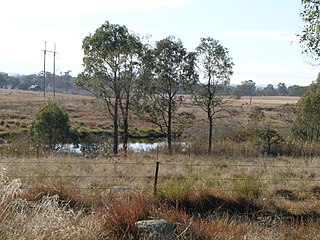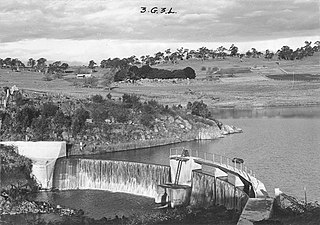The Border Rivers are a group of Australian rivers and the associated region near part of the state border between New South Wales and Queensland.
The rivers rise in the New England Tablelands bioregion and drain the western side of the Great Dividing Range as they collectively form part of the headwaters of the Darling River within the Murray-Darling basin. The eastern boundary of the Border Rivers catchment area extends along the Great Dividing Range divide from Stanthorpe in the north, to Guyra and Uralla, in the south. The western boundary of the region converges near the New South Wales town of Mungindi. [1] Collectively, the Border Rivers comprise a catchment area of 45,675 kilometres (28,381 mi). [2]
The Border Rivers flows through lands previously occupied by the Kamilaroi and Bigambul [3] and other indigenous people. [1] The Morella Watercourse, Boobera Lagoon, and Pungbougal Lagoon located on the Macintyre River floodplain is considered one of the most important Aboriginal places in eastern Australia. [1] [2] As one of the few permanent waterbodies in the northern Murray-Darling basin the complex provides refuge for wildlife during periods of drought. Sundown National Park also has ecological significance, hosting eleven rare and threatened animals, five rare or vulnerable plant species and permanent waterholes supporting a diverse range of waterbirds and aquatic biota. [2]
As of 2012 [update] the catchment supported a population of around 50,000 people. The main agricultural use of land is for grazing and dryland cropping, and this covers around ninety per cent of the catchment. Irrigation for the production of cotton occurs on the western plains between Goondiwindi and Mungindi. [3]
For approximately 450 to 470 kilometres (280 to 290 mi), [1] [3] [4] the Border Rivers form the border between New South Wales and Queensland, located in New South Wales between Tenterfield at its most eastern point, to Mungindi at its most western point. Unhelpfully, several rivers have been given the same name to separate watercourses located in each state.
Generally speaking the following rivers are considered to comprise part of the river group and region within Queensland: [5]
The following rivers either mark the New South Wales boundary with Queensland, or are fully located within the state and are considered to comprise part of the river group and region: [6]
Within New South Wales, both the Macintyre and Weir rivers drain to become the Barwon River, a major tributary of the Darling River within the Murray-Darling basin.
The Dumaresq River forms the border between Queensland and New South Wales, generally south-east of Bonshaw and Boggabilla. The Macintyre River forms the border west of Boggabilla to Mungindi.
The main activities in the Border Rivers region is agriculture. Crops are grown in areas with suitable conditions and the rest of the area is used for grazing. Because the rivers are quite small and erratic in flow, there is only small-scale irrigation.
The largest town in the western part of the Border Rivers region is Goondiwindi where the Newell Highway crosses the Macintyre River at the state border. The towns of Stanthorpe, in Queensland and Tenterfield, Glen Innes in New South Wales lie along the New England Highway on the eastern edges of the Border Rivers Basin. Inverell lies to the west on the western edge of the New England Tablelands. The central part of the Border Rivers region is rather underpopulated with no large towns, major transport routes, or significant industries other than agriculture. Small towns in the region include Texas, Inglewood, Ashford, Yetman, Bonshaw, Emmaville. [5] [6]

The Darling River is the third-longest river in Australia, measuring 1,472 kilometres (915 mi) from its source in northern New South Wales to its confluence with the Murray River at Wentworth. Including its longest contiguous tributaries it is 2,844 km (1,767 mi) long, making it the longest river system in Australia. The Darling River is the outback's most famous waterway.

Bruxner Highway, and its former western alignment as Bruxner Way, are a 420-kilometre (260 mi) state highway and rural road respectively, located in New South Wales, Australia. The route forms an east–west link across the Northern Tablelands in northern New South Wales, close to the border with Queensland, to the Northern Rivers coast. It was named after Michael Bruxner, NSW Minister for Transport from 1932 to 1941.

Bonshaw is a village in New South Wales, Australia 783 km north of Sydney. In the 2016 census, the village had a population of 133 people in the district. It is located near the northern border of the State close to Texas, Queensland, from which it is separated by the Dumaresq River which forms the border between the states. Bonshaw is located in Inverell Shire and Arrawatta County. It is on the Bruxner Highway between Tenterfield and Goondiwindi. It is a village designed to serve the needs of the agricultural holdings in the area.

Texas is a rural town and locality in the Goondiwindi Region of Queensland, Australia. It is on the Queensland border with New South Wales. In the 2021 census, the locality of Texas had a population of 790 people.

The Severn River, a perennial river that forms part of the Border Rivers group, is part of the Macintyre catchment of the Murray–Darling basin, located in the Northern Tablelands and North West Slopes regions of New South Wales, Australia.

The Macintyre River, a perennial river that forms part of the Border Rivers group, is part of the Barwon catchment of the Murray-Darling basin, located in the Northern Tablelands and North West Slopes regions of New South Wales, and the Southern Downs region of Queensland, Australia.

Barwon River, a perennial river that is part of the Murray–Darling basin, is located in the north-west slopes and Orana regions of New South Wales, Australia.

Goondiwindi is a rural town and locality in the Goondiwindi Region, Queensland, Australia. It is on the border of Queensland and New South Wales. In the 2021 census, the locality of Goondiwindi had a population of 6,230 people.

Boomi is a town in north western New South Wales, Australia. The town is in the Moree Plains Shire local government area, 728 kilometres (452 mi) north west of the state capital, Sydney, on the border on the New South Wales side of the MacIntyre River. Boomi is west of the Queensland town of Goondiwindi and north of Moree in New South Wales. At the 2016 census, Boomi and the surrounding farming area had a population of approximately 200.

The Dumaresq River ; a perennial stream of the Macintyre catchment within the Murray–Darling basin, is located in the Northern Tablelands and North West Slopes regions of New South Wales and the Darling Downs region of Queensland, Australia.
The Severn River, a perennial river that forms part of the Border Rivers group, is part of the Macintyre catchment of the Murray-Darling basin, located in the Darling Downs region of Queensland, Australia.

Toomelah is an Aboriginal Australian community in the far north of inland New South Wales, Australia.

Beardy Waters, a watercourse and part of the Macintyre catchment within the Murray–Darling basin, is located in the Northern Tablelands region of New South Wales, Australia.
The Mole River, a watercourse that is one of the Border Rivers and part of the Macintyre catchment within the Murray–Darling basin, is located in the Northern Tablelands region of New South Wales, Australia.
The Pike Creek, a perennial stream that is one of the Border Rivers and part of the Macintyre catchment within the Murray–Darling basin, is located in the Darling Downs region of Queensland, Australia

Beardy River, a perennial river that is part of the Murray–Darling basin, is located in the New England region of New South Wales, Australia.
The Boomi River, an anabranch of the Barwon River and part of the Macintyre catchment within the Murray–Darling basin, is located in the north–western slopes region of New South Wales, flowing downstream into the South Downs region of Queensland, Australia.
Deepwater River, a mostly perennial stream of the Dumaresq-Macintyre catchment within the Murray–Darling basin, is located in the Northern Tablelands district of New South Wales, Australia.
The Weir River, a river that is part of the Border Rivers group and also forms part of the Barwon River catchment in the Murray–Darling basin, is located in the Darling Downs region of Queensland, Australia.

Bungunya is a rural town and locality in the Goondiwindi Region, Queensland, Australia. The locality is on the border of Queensland and New South Wales. In the 2021 census, the locality of Bungunya had a population of 62 people.
![]() This article incorporates text available under the CC BY 3.0 AU licence.Required attribution: © Commonwealth of Australia.
This article incorporates text available under the CC BY 3.0 AU licence.Required attribution: © Commonwealth of Australia.